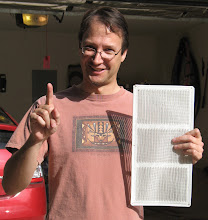I have attempted to take into account some of this memory by replotting the energy use (kWh) vs. Cooling Degree Days (CDD) data, but with the following change: the CDD numbers on the X axis are the sum of the current CDD value added to a factor times the previous month's CDD value. For for a given month on this plot,
Accumulated CDD = (Factor * previous CDD) + CDD for this month
I utilized the Standard Error function in Excel, STEYX(), to assist me in determining the value of "Factor" by trial and error. I chose a value for "Factor" that minimzed the total standard error of the function; i.e. the sum of the errors of Y as they can be predicted by X. In another intriguiging twist, this yielded a value of greater than 1; in fact, a value around 2.6 actually worked best.
What does this mean? This means that last month's weather matters a lot more (2.6 times more) than this month's weather in determining how much heat is going to entering my home. Another fascinating result, suggesting that once again, simple air convection or conduction (represented by this month's CDD) through the exterior of the house has a lot less to do with cooling load than radiation of the hot environment around me (represented by last month's CDD). Another argument for full-house radiant barriers, if anyone is listening! In fact, the low-emissivity ("low-e") coating on modern windows helps perform exactly that radiant barrier function, but on the sides of the house, somewhere that my attic-based radiant barrier doesn't cover, and something I hope to learn more about in the future. So far, replacing windows has been off of my list due to cost constraints (my entire radiant barrier cost a lot less than 1 window), but there are efficiencies to be gained there as well. But I digress...
I actually also tried this model with a second factor multiplied by the CDD from 2 months ago, but trial and error yielded almost no impact: the factor was less than 0.1. This indicates that the main factors are (in order of importance) last month's temperature, then this month's temperature.

You'll notice a few things right off the bat:
- The "best fit" lines look a little high. The reason: I made them fit starting at 500 accumulated CDD; I considered everything to the left of that as noise. So the slopes should match the hottest (right hand) part of the curve well, even if their level looks high. The slope is what I'm after; we're going to ignore the intercept (height) of the lines.
- If you compare to the previous 2005 graph, you'll see that the effect of using accumulated CDDs has been to turn the large loop of 2005 data into a double loop, with a crossing in the middle. Intuitively that makes sense: that minimizes the error between a line drawn through the middle of the loop and the loop itself. The standard error for the raw 2005 CDD data was 564; the standard error for accumulated CDD data is 473, a significant improvement, meaning that a line fits this data better (although clearly still not great!)
- If you compare to the previous 2009 graph, you'll see that the effect of using accumulated CDDs has been to turn the small loop of 2009 data into almost an exact line. The fact that it's a nice fit for the line means that the house's response to temperature has become much more linear; the "loopy" nonlinear part only appears far to the right in the hottest areas. The standard error for the raw CDD data for 2009 was 141; for the accumulated data, it drops to 95. Looking at the graph, you can see that the best-fit line matches quite well.
2005: 0.99 kWh / accumulated CDD
2009: 0.27 kWh / accumulated CDD
Taking reciprocals to convert to effectiveness:
2005: 1.01 accumulated CDD cooled per kWh spent
2009: 3.73 accumulated CDD cooled per kWh spent
Effectiveness ratio: 3.7 to 1
Conclusion: when taking the hysteresis of the system into account, our home improvements look even better. Rather than a 70% improvement in effectiveness based on the immediate CDD method, I may well be looking at a 73% improvement based on a more accurate model.
While not a massive change, this analysis makes me feel a bit better in that I've now accounted for the rather obvious hysteresis in the data, and come out with pretty similar numbers.
There remains the lingering question of the nonlinearity all through the 2005 data and at the very far right of the 2009 data. It would appear that when things get hotter than the house can handle (which seems to happen immediately in 2005, but not until about x=2000 accumulated CDDs in 2009), energy use gets bumped up nonlinearly. There are probably good physics reasons for this nonlinearity, but I will leave it to my readers to write in a let me know what they might be and how I might model them - or even better, prevent them!
In the meantime, this diversion into analysis was fun, but we still have a little bit more story to tell about the home energy efficiency projects completed in 2009. Stay tuned!


No comments:
Post a Comment